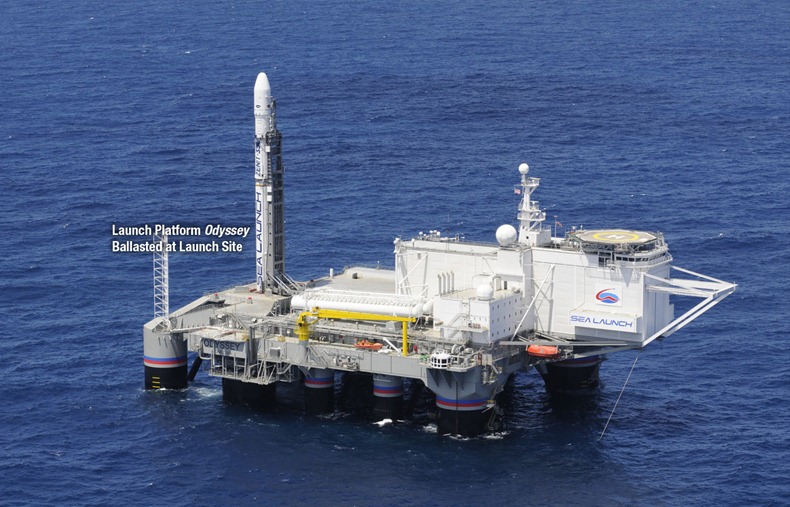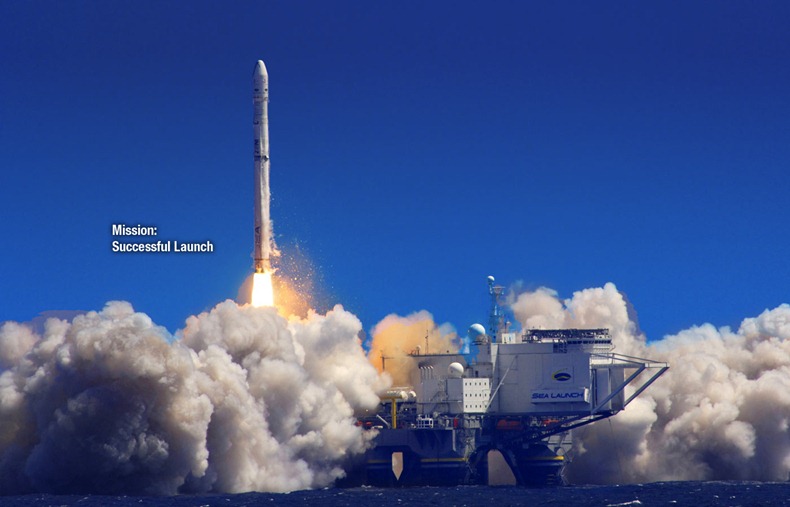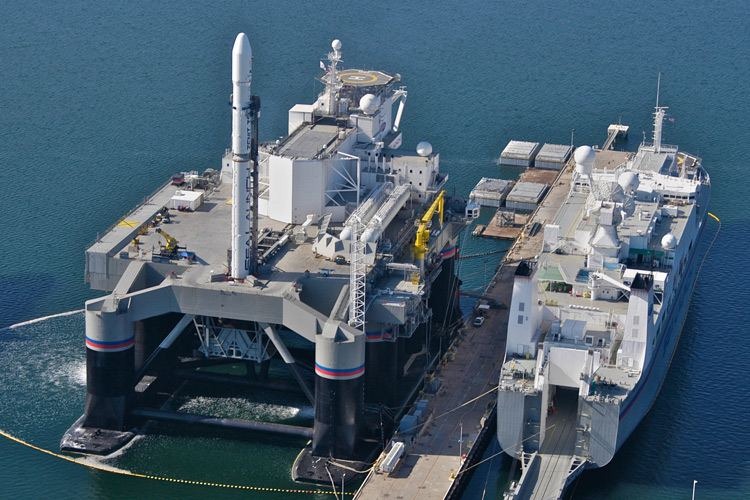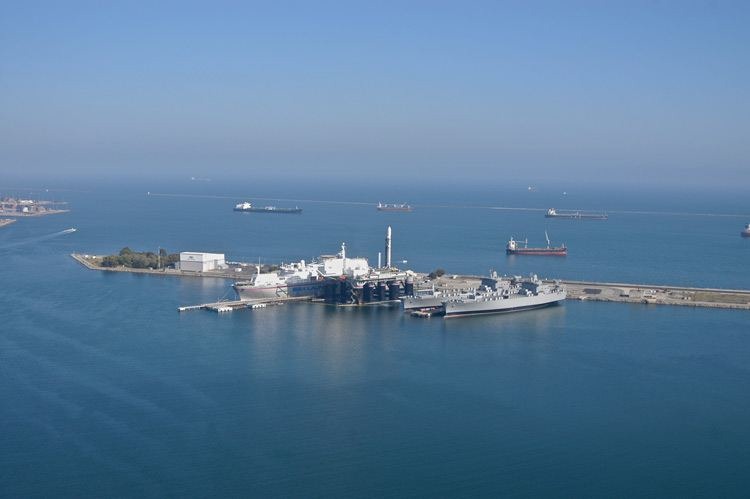The two giant ships, a NASA-like mission control and a launch pad floating on the ocean, form part of an audacious, outrageously expensive, multi-national venture for blasting commercial satellites into space. Sea Launch was established in 1995 as a consortium of four companies from Norway, Russia, Ukraine and the United States, managed by Boeing with participation from the other shareholders. Operated by the Russians, this commercial spacecraft launch service uses a mobile sea platform for equatorial launches of payloads on specialized Zenit 3SL rockets. Since the first rocket flight on March 1999, it has assembled and launched thirty-one rockets, with three failures and one partial failure.
But why launch from the sea when there are land based launching sites, you may ask? Launching from a vessel allows engineers to move the launch pad closer to the equator of the earth, and take advantage of the greater rotational speed of the Earth to provide an extra boost to the launch. Earth’s rotation speed at the equator is 1,674 km/hr. In contrast, the rotational speed of the Earth at Kennedy Space Center, for example, which is located at 28.59° North latitude, is 1,470.23 km per hour. Rockets launched from near the equator thus gains an additional 200 km/hr boost, compared to those launched from Kennedy Space Center.
Launching satellites into geosynchronous orbit (allowing the satellite to keep pace with the earth’s rotation) from the equator has another advantage: there is no need to change plane, as the satellites are launched from the same plane as that of the geostationary orbit. This provides another boost as no energy is spent orienting the vehicle. This allows 17.5%-25% more mass to be launched to geostationary orbit than the same rocket launched from Kennedy Space Center.
The ship and launch platform operate from the home port in Long Beach, California., where the customer satellite is encapsulated in a Boeing-built fairing/adapter. The satellite is moved to the ship, where it is mated to the three-stage rocket, which then is moved to the launch platform for transportation to the launch site, where it is moved into upright position. The rocket is automatically fueled and launched as engineers and customers control events from the nearby command ship.
Sea Launch rockets are assembled in Long Beach, California. The typical assembly is done on board the Assembly and Command Ship (the payload is first tested, fueled and encapsulated in the nearby Payload Processing Facility). The rocket is then transferred to a horizontal hangar on the self-propelled launch platform.
Following rocket tests, both ships then sail about 4,828 km to the equator at 154° West Longitude,
With the platform ballasted to its launch depth of 22 m, the hangar is opened, the rocket is mechanically moved to a vertical position, and the launch platform crew evacuates to the command ship which moves about five kilometers away. Then, with the launch platform unmanned, the rocket is fueled and launched. The final ten seconds before launch are called out simultaneously in English and Russian.
| Number | Date | Payload | Mass | Result |
|---|---|---|---|---|
| 1 | 1999-03-27 | DemoSat | 4.5 t | success |
| 2 | 1999-10-09 | DIRECTV 1-R | 3.5 t | success |
| 3 | 2000-03-12 | ICO F-1 | 2.7 t | failure |
| 4 | 2000-07-28 | PAS-9 | 3.7 t | success |
| 5 | 2000-10-20 | Thuraya-1 | 5.1 t | success |
| 6 | 2001-03-18 | XM-2 ROCK | 4.7 t | success |
| 7 | 2001-05-08 | XM-1 ROLL | 4.7 t | success |
| 9 | 2002-06-15 | Galaxy IIIC | 4.9 t | success |
| 9 | 2003-06-10 | Thuraya-2 | 5.2 t | success |
| 10 | 2003-08-07 | EchoStar IX/Telstar 13 | 4.7 t | success |
| 11 | 2003-09-30 | Galaxy XIII/Horizons-1 | 4.1 t | success |
| 12 | 2004-01-10 | Telstar 14/Estrela do Sul 1 | 4.7 t | success |
| 13 | 2004-05-04 | DIRECTV-7S | 5.5 t | success |
| 14 | 2004-06-28 | Telstar-18 | 4.8 t | launch anomaly |
| 15 | 2005-03-01 | XM-3 | 4.7 t | success |
| 16 | 2005-04-26 | SPACEWAY-1 | 6.0 t | success |
| 17 | 2005-06-23 | Intelsat IA-8 | 5.5 t | success |
| 18 | 2005-11-08 | Inmarsat 4-F2 | 6.0 t | success |
| 19 | 2006-02-15 | EchoStar X | 4.3 t | success |
| 20 | 2006-04-12 | JCSAT-9 | 4.4 t | success |
| 21 | 2006-06-18 | Galaxy 16 | 5.1 t | success |
| 22 | 2006-08-22 | Koreasat 5 | 4.9 t | success |
| 23 | 2006-10-30 | XM-4 | 4.7 t | success |
| 24 | 2007-01-30 | NSS-8 | 5.9 t | failure |
| 25 | 2008-01-15 | Thuraya-3 | 5.2 t | success |
| 26 | 2008-03-19 | DirecTV-11 | 5.9 t | success |
| 27 | 2008-05-21 | Galaxy 18 | 4.6 t | success |
| 28 | 2008-07-16 | EchoStar XI | 5.5 t | success |
| 29 | 2008-09-24 | Galaxy 19 | 4.7 t | success |
| 30 | 2009-04-20 | SICRAL 1B | 3.0 t | success |
| 31 | 2011-09-24 | Atlantic Bird 7 | 4.6 t | success |
| 32 | 2012-05-31 | Intelsat 19 | 5.6 t | success |
| 33 | 2012-08-19 | Intelsat 21 | 6.0 t | success |
| 34 | 2012-12-03 | Eutelsat 70B | 5.2 t | success |
| 35 | 2013-02-01 | Intelsat 27 | 6.2 t | failure |







Where do you source all this stuff from Mr. Markoson! This launching method is practical, economical and reasonably efficient, isn’t it? Why do some of us feel guilty when we see these polluting monsters belching out all that carbon over the lovely old ocean? Better than blowin each other up though eh? Mind as well reach for the stars, ain’t find’in many answers down here. Just hope we don’t carry any cancers out beyond big blue here..Get my name on the list for a ticket…..I want my ashes spread on a crater over Mars. Is that asking too much?